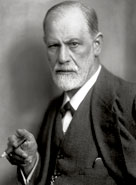Exercise 4. Translate the sentences in Past Simple Passive and Active
1) Freud entered the University of Vienna at the age of 17.
2) The patient’s dreams were analyzed by Freud.
3) Hysteria was described by Freud in 1885.
4) In 1900, Freud published The Interpretation of Dreams.
5) In January 1933, the Nazis took control of Germany, and Freud’s books were burnt and destroyed.
6) Freud used hypnosis in his practice.
Exercise 5. Read the text. Be ready to tell briefly about Sigmund Freud’s life
SIGMUND FREUD (1856 – 1939)
 Freud was an Austrian neurologist and the founder of psychoanalysis, who created an entirely new approach to the understanding of the human personality. He is regarded as one of the most influential and controversial minds of the 20th century.
Freud was an Austrian neurologist and the founder of psychoanalysis, who created an entirely new approach to the understanding of the human personality. He is regarded as one of the most influential and controversial minds of the 20th century.
Sigismund (later changed to Sigmund) was born on 6 May 1856 in Freiberg, Moravia (now Pribor in the Czech Republic). His father was a merchant. The family moved to Leipzig and then settled in Vienna, where Freud was educated.
In 1873, Freud began to study medicine at the University of Vienna. After graduating, he worked at the Vienna General Hospital. He treated hysteria by the recall of painful experiences under hypnosis. In 1885, Freud went to Paris as a student of the neurologist Jean Charcot. On his return to Vienna the following year, Freud set up in private practice, specializing in nervous and brain disorders. The same year he married Martha Bernays, with whom he had six children.
Freud developed the theory that humans have an unconscious in which sexual and aggressive impulses are in perpetual conflict. In 1897, he began an intensive analysis of himself. In 1900, his major work ‘The Interpretation of Dreams’ was published in which Freud analyzed dreams in terms of unconscious desires and experiences.
In 1902, Freud was appointed Professor of Neuropathology at the University of Vienna. Although the medical establishment disagreed with many of his theories, a group of pupils and followers began to gather around Freud.
After World War One, Freud spent less time in clinical observation and concentrated on the application of his theories to history, art, literature, and anthropology. In 1923, he published ‘The Ego and the Id’, which suggested a new structural model of the mind.
In 1933, the Nazis publicity burnt a number of Freud’s books. In 1938, shortly after the Nazis annexed Austria, Freud left Vienna for London with his wife and daughter Anna.
Freud had been diagnosed with cancer of the jaw in 1923 and underwent more than 30 operations. He died of cancer on 23 September 1939.
Exercise 6. Answer the questions
1) What is Sigmund Freud famous for?
2) What did Freud study at the University of Vienna?
3) How did Freud treat hysteria?
4) What theory did Freud develop?
5) What is Freud’s most important work?
6) What did Freud suggest in his work ‘The Ego and the Id’?
7) What disease did Freud suffer from?
Exercise 7. Translate into English
Засновник психоаналізу, суперечливий розум, вивчати медицину, пригадування болючих переживань, під гіпнозом, нервові розлади, розлади мозку, теорія несвідомого, «Тлумачення снів», несвідомі бажання і переживання, «Я і Воно», група учнів та послідовників, клінічні спостереження, нова структурна модель психіки, померти від раку
Exercise 8. Put questions to the underlined words
1) In 1859 the Freud family left Freiberg.
2) Freud believed that smoking enhanced his capacity to work.
3) Psychoanalysis remains influential in psychotherapy and psychiatry.
4) Freud read William Shakespeare in English throughout his life.
5) Sexual and aggressive impulses are in perpetual conflict.
6) Neuroses can be cured by psychoanalysis.
7) The question of the therapeutic effectiveness of psychoanalysis remains an open and controversial one.
Exercise 9.Write the following sentences in the Past
1) The new hypothesis is developed by German scientists.
2) Psychology students study anatomy in the first year.
3) Brain disorders are diagnosed in some newborn babies.
4) The concept of unconscious is considered central to Freud’s theory of mind.
5) The psychotherapist treats patients with hysteria and other disorders.
6) Students spend a lot of time in clinical observations.
Exercise 10. Open the brackets. Translate
1) Freud (to develop) a clinical method for treating psychopathology.
2) Psychoanalysis (to use) by psychologists and psychiatrists nowadays.
3) In 1859 the Freud family (to go) to Leipzig.
4) Freud’s mother Amalia (to be) 20 years her husband junior.
5) The Psychopathology of Everyday Life (to publish) in 1901.
6) Freud (to believe) that cocaine was a cure for many mental and physical problems.
7) Neurology (to deal with) disorders of the nervous system.
*Exercise 11. Read about Freud’s aptitude for languages
A polyglot is someone who can speak many languages, basically a super-linguist. And Sigmund Freud was a serious polyglot, with strong knowledge of German, Italian, Greek, English, Spanish, Hebrew and Latin. Freud was also quite the little genius, already reading Shakespeare at the tender age of eight. He was also accepted into a prestigious high school and graduated with honors, eventually proving himself as the most eccentric psychologist ever to walk the Earth.
Завдання для самостійної роботи студентів
1) Перекладіть словосполучення на англійську мову і складіть з ними речення
Засновник психоаналізу
Теорія несвідомого
Тлумачення снів
Нервові розлади
Несвідомі бажання і переживання
2) Дайте відповідь на питання
What is Sigmund Freud famous for?
What theory did Freud develop?
What is Freud’s most important work?
HUMAN BODY